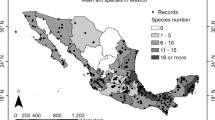Abstract
Ant records for Lower Austria date back to 1802. Since then, the number of presently recognized central European ant species has increased from 34 to 165. Taxonomic changes and former misidentifications have unfortunately made published historical data unreliable. Therefore, in preparing for the publication of the Red List of Ants of Lower Austria, all voucher specimens from the available major collections were redetermined at the species level. This amounted to a total of 18500 pre-1980 specimens, and 42000 post-1980 specimens. Currently, there are 111 ant species recorded for Lower Austria (including three introduced species). Twelve of these are published here for the first time for Lower Austria, six for all Austria, and one of these is a so far unknown species, discovered among historic voucher specimens. Voucher specimens provide information on the pre-1980 situation of 108 (=97% of the known) species and 32% of the surface area of Lower Austria.
Similar content being viewed by others
References
Agosti D. 2002. Social Insects World Wide Web SIWeb, Antbase. http://research.amnh.org/entomology/ social-insects.
Arnoldi K.V. 1977. New and little known species of ants of the genus Leptothorax Mayr (Hymenoptera, Formicidae) from the European part of the USSR and Caucasus. Revue d'Entomologie de l'URSS 56: 198–204.
Bolton B. 1977. The ant tribe Tetramoriini (Hymenoptera: Formicidae). The genus Tetramorium Mayr in the Oriental and Indo-Australian Regions, and in Australia. Bulletin of the British Museum of Natural History (Entomology) 36: 67–151.
Cabela A., Grillitsch H. and Tiedemann F. 1997. Rote Listen ausgewählter Tiergruppen Nieder-österreichs ¶ Lurche und Kriechtiere (Amphibia, Reptilia). Amt der NÖ Landesregierung, Wien, Austria.
Hölldobler B. and Wilson E. 1990. The Ants. The Belknap Press of Harvard University Press, Cambridge, Massachusetts.
Hölzel E. 1966. Hymenoptera¶Heterogyna: Formicidae. Catalogus Faunae Austriae 16: 1–12.
Höttinger H. and Pennerstorfer J. 1999. Rote Listen ausgewählter Tiergruppen Niederösterreichs ¶ Tagfalter (Lepidoptera: Rhopalocera and Hesperiidae). Amt der NÖ Landesregierung, St. Pölten, Austria.
Kratochvil J., Novak V. and Snoflak J. 1944. Mohelno. 5. Hymenoptera ¶ Aculeata. Formicidae ¶ Apidae ¶ Vespoidea. Archiv des Verbandes für Natur-und Heimatschutz in Mähren 6: 1–132.
Kutter H. 1977. Hymenoptera: Formicidae. Fotorotar AG, Zürich, Switzerland.
Latreille P.A. 1802. Histoire naturelle des fourmis. Imprimerie de Crapelet (chez T. Barrois), Paris.
Markó B. and Csösz S. 2002. Die europäischen Ameisenarten (Hymenoptera: Formicidae) des Hermann-städter (Sibiu, Rumänien) Naturkundemuseums I: Unterfamilien Ponerinae, Myrmicinae und Dolichoderinae. Annales Historico-Naturales Musei Nationalis Hungarici 94: 109–121.
ÖGA 1995. Bemerkenswerte Ameisenfunde aus Österreich und angrenzender Gebiete (Hymenoptera: Formicidae). Myrmecologische Nachrichten 1: 1–3.
Raab R. and Chwala E. 1997. Rote Listen ausgewählter Tiergruppen Niederösterreichs ¶ Libellen (Insecta: Odonata). Amt der NÖ Landesregierung, Wien, Austria.
Ressl F. 1995. Naturkunde des Bezirkes Scheibbs, Tierwelt (3). Naturkundliche Botanische Arbeits-gemeinschaft am Biologiezentrum/ Oberösterreichisches Landesmuseum, Linz, Austria.
Schultes J.A. 1802. Kleine Fauna und Flora von der sudwestlichen Gegend um Wien bis auf den Gipfel des Schneeberges. Degen, Wien, Austria.
Schweiger H. 1962. Die Insektenfauna des Wiener Stadtgebietes als Beispiel einer kontinentalen Groß-Stadtfauna. Internationaler Kongreß für Entomologie III: 184–193.
Seifert B. 1988. A revision of the European species of the ant subgenus Chthonolasius (Insecta, Hymenoptera, Formicidae). Entomologische Abhandlungen des Museums für Tierkunde Dresden 51: 143–180.
Seifert B. 1996. Ameisen: beobachten, bestimmen. Naturbuch Verlag, Augsburg, Germany.
Seifert B. 2000. Rapid range expansion in Lasius neglectus (Hymenoptera, Formicidae) ¶ an Asian invader swamps Europe. Mitteilungen des Museums für Naturkunde Berlin, Deutsche Entomologische Zeitschrift 47: 172–179.
Steiner F.M. and Schlick-Steiner B.C. 2002. Einsatz von Ameisen in der naturschutzfachlichen Praxis. Begründungen ihrer vielfaltigen Eignung im Vergleich zu anderen Tiergruppen. Naturschutz und Landschaftsplanung 34: 5–13.
Rights and permissions
About this article
Cite this article
Schlick-Steiner, B.C., Steiner, F.M. & Schödl, S. A case study to quantify the value of voucher specimens for invertebrate conservation: ant records in Lower Austria. Biodiversity and Conservation 12, 2321–2328 (2003). https://doi.org/10.1023/A:1024592408749
Issue Date:
DOI: https://doi.org/10.1023/A:1024592408749




